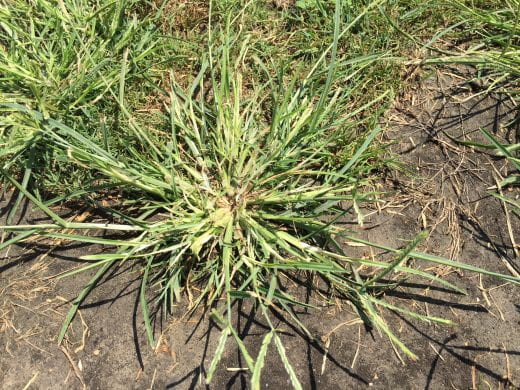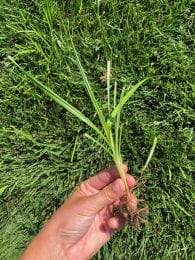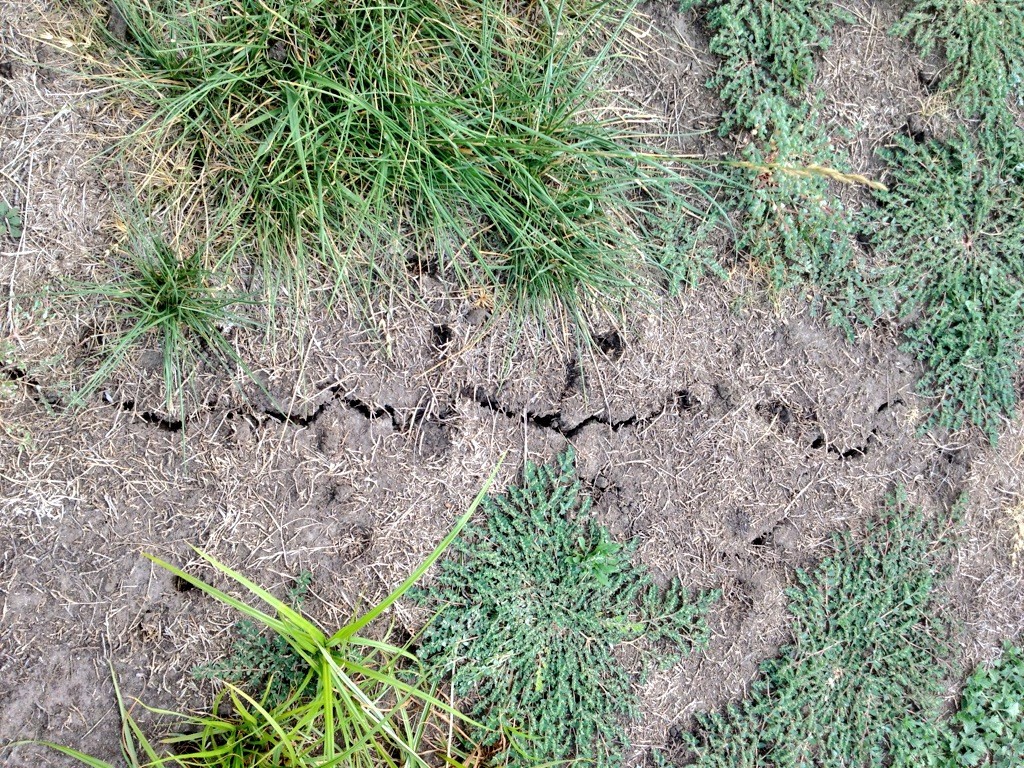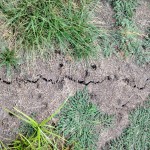(By Jared Hoyle, KSU Turfgrass Research and Extension)
As a turfgrass manager, as soon as you think you have it under control… BAM, you are under attack. Just in a short period of time Manhattan has been under attack from weeds. Now many of these weeds are large and hard to control.

With all the rain earlier in the season there was standing water in many of the low areas of the research farm. The turf did not like it and eventually died. But what did like it was yellow nutsedge. I put up some information about this in the recent past but, it is everywhere and I am still getting phone calls about it so I wanted to direct you to the most recent post on controlling yellow nutsedge.
https://blogs.k-state.edu/turf/yellow-nutsedge-reported-across-ks/
Also, you can use glyphosate to treat yellow nutsedge in landscape beds but it only provides marginal control. Remember not to use glyphosate to treat yellow nutsedge in your turf.

Crabgrass galore! Slow to start but it is going strong now! Anywhere we didn’t put down a preemergent herbicide this year crabgrass has started to take over. Good thing there is options for control. Check out my earlier post for crabgrass options. Pay attention to control options for larger tillered crabgrass.
https://blogs.k-state.edu/turf/postemergent-crabgrass-control-2/

If it is not yellow nutsedge or crabgrass it is goosegrass. Back in early June, goosegrass emergence was reported across Kansas. Now the goosegrass is growing and going to be more difficult to control because it has tillered out. Make sure you make your follow-up applications when recommended and choose your control options that are effective on larger goosegrass.
If you have cool-season turfgrass then you can use fenoxaprop (Acclaim Extra), fluazifop (Fusilade II), tropramizone (Pylex), or MSMA (golf courses and sod farms only!). You will have to do more than one application since the goosegrass is tillered out. Sulfentrazone (Dismiss) is also effective on goosegrass if it has not tillered out yet so might want to go with another option since now the goosegrass is big.
For all you golf courses out there that have creeping bentgrass fairways it is going to be a little bit more difficult because the herbicides that work best tend to injure the turf. 1-Tiller or smaller can be controlled with fenoxaprop (Acclaim Extra) at 3.5 fl oz/A but you will need to re-apply every two weeks to make sure you are applying to small plants. This could be a follow-up option if new goosegrass starts to emerge before the season it over.
As crazy as it sounds a herbicide that has commonly been used for broadleaf weeds has shown control on goosegrass. SpeedZone (2,4-D +dicamba + MCPP) has shown control but a follow up application is going to be needed 30 days after initial application. Pay attention to the temperature restrictions in this heat!
Tropramizone (Pylex) can be used on bentgrass at lower rates (0.25 fl oz/A) but definitely need a repeat application at 21 days
Now if you have bermudagrass or zoysiagrass then you can use Tribute TOTAL (thiencarbazone + foramsulfuron + halosulfuron). Fusilade II and Acclaim Extra that works in cool-season grass can also be used on zoysiagrass. If you mix these products with triclopyr (Turflon Ester Ultra or Triclopyr 4) then you will get better results.
Always remember to READ THE LABEL for the correct rate, turfgrass tolerance, and specific instructions before application!!!
Information in this article is from Turfgrass Weed Control for Professionals.
Patton, A.J., M. Elmore, J. Hoyle, J. Kao-Kniffin, B. Branham, T. Voigt, N. Christians, A. Thoms, G. Munshaw, A. Hathaway, T. Nikolai, B. Horgan, L. Miller, X. Xiong, W. Kreuser, R. Gaussoin, D. Gardner, Z. Raudenbush, D. Li, P. Landschoot, D. Soldat, and P. Koch. 2019 Turfgrass Weed Control for Professionals. Purdue University Extension Publication. TURF-100. pp. 128.
Get your copy here – https://www.bookstore.ksre.ksu.edu/Item.aspx?catId=545&pubId=20239
***Mention of trade names or commercial products in this article is solely for identification purposes and does not imply recommendation or endorsement, nor is criticism implied of similar products not mentioned by Kansas State University.***
Don’t forget to follow me on twitter @KSUTurf.
Also, visit our facebook page www.facebook.com/KSUTurf


 If using a herbicide application timing is critical. During mid-summer, yellow nutsedge starts making tubers and if you apply herbicides before tuber production you will get better control. If you wait until the yellow nutsedge is big and starting to make tubers then you will be playing catch-up all year. So sooner is better. Don’t wait for it to get too big.
If using a herbicide application timing is critical. During mid-summer, yellow nutsedge starts making tubers and if you apply herbicides before tuber production you will get better control. If you wait until the yellow nutsedge is big and starting to make tubers then you will be playing catch-up all year. So sooner is better. Don’t wait for it to get too big.







